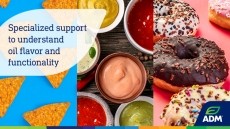Californian trans fat ban takes effect
Evidence has mounted over the past decade showing that trans fats clog arteries and cause heart disease. On the back of growing concern, the Food and Drug Administration (FDA) issued a regulation which was implemented in 2006 requiring manufacturers to list trans fatty acids on the nutrition panel of foods, providing further motivation for manufacturers to cut trans fats from their products.
The new Californian law means that all oils, margarines and shortenings used in frying must contain less than 0.5 percent trans fat per serving. Food manufacturers and restaurants that violate the legislation face fines of up to $1,000.
The ban was signed into law in July 2008, but was not put into practice until the beginning of this year in order to allow manufacturers time to reformulate with alternative fats and oils.
Exceptions to the state-wide ban include baked and deep-fried items, with manufacturers having until 2011 to switch from artificial trans fats.
Bans have also been implemented in several cities, including New York City and Philadelphia, as well as parts of Maryland. But there has been controversy about how easy or difficult it is for manufacturers to reformulate with non-hydrogenated fats, and California is the first state to impose a ban.
Hydrogenation of oils, essentially turning them into semi-solids, gives them a higher melting point and extends their shelf life, making them better suited for use by the food industry. Trans fats in the form of partially hydrogenated oils are also cheaper to produce than healthier oils like sunflower or olive oil. Therefore, margarines and commercially produced shortenings in the US have traditionally contained high levels of hydrogenated fats.
Artificial trans fat is most common in baked and fried foods, in which it can count for up to 45 percent of total fat content.
The trans fat bans that have been instigated refer to these artificial trans fats, but it also occurs naturally. It makes up two to five percent of total fat content in dairy products and beef, for example.
The World Health Organization has recommended an upper limit of one percent of a person’s daily energy to come from trans fat.
Denmark was the first country to set an upper limit on trans fats as a percentage of total fat content in a food item – and set it at two percent in 2003.












